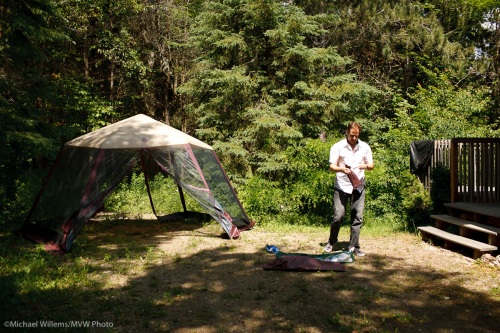The sun, most photographers would agree, is not the friendliest light. It is like a studio with one direct light:
- Too contrasty for the camera’s dynamic range to handle dark to light;
- It throws shadows;
- It makes smooth surfaces (like, um, skin) look wrinkly.
So you get this, of Joseph Marranca on Monday at the Mono, Ont venue of the advanced creative light workshops:
Nice, but it suffers from all the problems of direct sunlight.
When you would rather have this, two seconds later when the sun went behind a big sky-mounted softbox: a cloud.
Nice and soft. Saturated colours. Smooth.
Now the only problem is that if you want highlights, you don’t get them. Can’t we have both?
Yes. And that is where flash comes in.
In the portrait shot below of Oakville’s mayor, yesterday, I first took away the sun, using a diffuser. And then I added a flash. Off-camera , with a Honl grid and a Honl quarter CTO gel (with my white balance set to flash). Plus a bit of fill flash on the camera.
I think that being in control is better than just relying on too-harsh direct light. Do you agree?




Michael: great portrait shot – says “Oakville” and “Mayor”. But could you please expand on taking away the sun with a diffuser?
Oh, of course. A diffuser is a white translucent sheet. Mine is actually part of a small fold-up round 5-way reflector: take away the reflective (silver or gold or white or black) cover, and it becomes a diffuser that lets through light but softens it. Hold that above the person’s head: presto, no sunlight.
Fantastic! So it filters the sunlight en route to the sensor. Thanks.